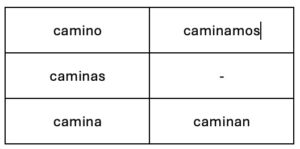One of the universal hurdles for Spanish learners is verb conjugations. (No surprise there.) I’ve struggled with it, and have myself tried different methods to get over the verb conjugation mountain. These have included apps for drilling different conjugations (Conjugato and Conjuu, for instance), general language apps (like Clozemaster and Babbel), trying to memorize by mental repetition (just in my head), trying to memorize by writing the conjugation repeatedly, reviewing flashcards of the conjugated forms, using ChatGPT to quiz me and help me review the different conjugations, and I’ve even given learning by “osmosis” a try (through watching a lot of comprehensible input and nothing else).
I want to tell you the simplest and single best way I’ve found to learn the conjugated form of a verb. It’s very basic, but effective. Before I get into it, I want to share a couple of pointers:
- Some parts learning Spanish simply require repetition and rote memorization, and there isn’t a “shortcut”. I think this is the case with the various conjugations – you just have to put the work in.
- It gets easier to “know” and to memorize the conjugations the further along you get. At some point, conjugations just won’t seem so hard (even though they seem impossible at first).
- This method is simple, but involves some repetition – so don’t spend too long on this in a single session. In other words, work on this a short while but quit before it becomes unpleasant. 10 minutes, one or two times a day should be enough to get you very far if you’re consistent.
- Work on one verb in one tense at a time when doing this. When you’ve mastered one, then move onto a different verb in the same tense.
- For the regular verbs, after you’ve learned a few of the same type of verb (-ir, -er, -ar) the rest will be easy.
- I recommend tacking Present Indicative first, then Preterite, then Imperfect.
- Some initial verb suggestions: saber, querer, ser, ir, tener, haber, decir, hacer, dar. (Those are some of the most often used verbs.)
So what is the method? It is a simple exercise involving writing to reinforce your memory. Download my printable verb conjugation practice sheet first. It looks like this:
The verb practice sheet provides you a structured format to write down the conjugation for a single tense, repeatedly. The idea is for you to write it down enough times to memorize it (old-school style). That’s what each of the grids is for – you should fill in the conjugation chart by hand after you print the practice sheet, like this:

[You will notice I omitted the “vosotros” form, because I want to focus on Spanish as it’s used in Latin America (Mexico, specifically). But you should fill in the vosotros form of the conjugation if that’s part of what you’re learning.]
I can guess what some of you might be thinking – yes, it’s a bit boring. And it somewhat goes against the philosophy of some methods (such as the Dreaming Spanish method, which I actually like a lot). But I think repetition and memorization has it’s place. It can help you progress, and I think it’s just something we need to do with certain information sets.
So how many times do you need to do this? And for how long? To quote professor Timothy Shanahan from his answer to a question about how many times a student needs to write a word to memorize it:
“Basically, these studies suggest that the number of repetitions needed to learn a word is about 10-15 times, with lots of variation – among kids and words. For example, poor readers may require 12-25 reps to ‘learn’ a word, while better readers may get away with only 8-12 (Lemoine, Levy, & Hutchison, 1993).”
The answer is: There’s no “set amount” of repetitions guaranteed to help you learn a word (or a group of words, like conjugations) because everyone is different. So you may only need to print a few copies of the practice sheet, and you might memorize the conjugations in a few days. For others (like me) it can take a few more tries before the information becomes solidified in the memory. If you complete one copy of the sheet, you’ve written the conjugations 8 times. If you do that for 3 days, you’ve hit the upper limit of repetitions mentioned by Prof. Shanahan.
But you want to do it until you can write the conjugation chart perfectly, from memory, without making any mistakes. I suggest you do it in this sequence:
- Write the infinitive of the verb at the top of your sheet. (For example, you would write caminar.)
- Look at the verb conjugation chart in a verb book or online, and copy it in the first (upper-left) grid.
- With a blank sheet of paper, cover the correct grid you just filled out and try to fill the second grid in from memory.
- Check your work. If you got any part of it wrong, put an “X” over the grid you just filled out.
- Copy the next grid by looking at your reference.
- Repeat step 3-5.
You obviously need to reach the point where you are not looking at a reference to get the correct answers, but you are correctly filling in a full sheet repeatedly from memory.
There’s nothing revolutionary or inventive about this method, but it will help you accomplish what you need to do: learn the conjugations. I think this is the best single way to learn the conjugations, but repetition is best paired with other methods – specifically taking in comprehensible input and real-life usage (like implementing new words in your writing and speaking).
If you simply consistently use the sheet and follow the steps, you will learn the conjugations – I know you will! And I wish you the best of success in your Spanish language learning journey.
Free Resources:


